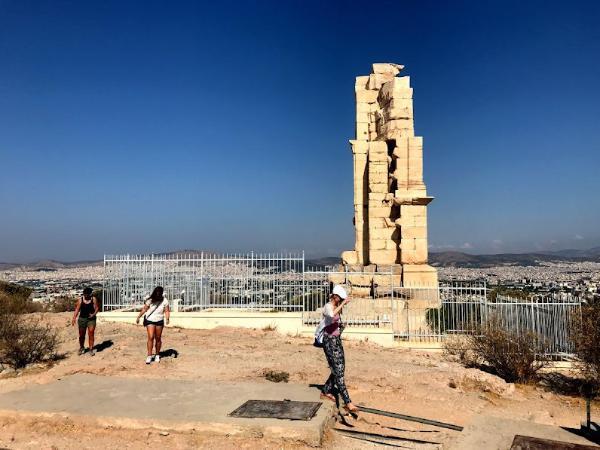
Philopappos Hill is a park located right southwest of the Acropolis in the very heart of Athens, Greece. The park covers an area of 700 square km and the highest point of the hill reaches an elevation of 147 meters AMSL. The hill takes its name from the prominent monument that stands on its top: the mausoleum of a mogul and benefactor of Athens who lived in the 1st and 2nd centuries AD and went by the name Philopappos. In antiquity, it was known as the Hill of the Muses and in the Middle Ages as Seggio Hill. Philopappos Hill, as well as the adjacent hills of Pnyx and Nymphs, is today a favorite spot for Athenians and tourists alike who go there to have a pleasant walk through the park’s serene environs, visit its various historical monuments, and wonder at the unparalleled views from its top.
Contents
- How to get there
- Entrance Fee
- Opening Hours
- View
- History of Philopappos Hill
- Sights within Philopappos Hill Park
- Saint Dimitrios Loumbardiaris Medieval Church
- Kimon’s Tomb
- Ancient Deme of Koile
- Dora Stratou Greek Dances Theatre
- Seven Seats Plateau
- Andero
- Philopappos Monument
- Prison of Socrates
- Recommended Walk
- Philopappos Hill Map
- Safety
- Photo Gallery
How to get there
The Park of Philopappos Hill may be accessed by various points around its periphery. The main entry is located at the joining of Apostolou Pavlou, Dionysiou Areopagitou, Robert Galli, and Theorias streets, below the southwestern slope of the Acropolis; 700 meters south of Thissio Metro Station and 500 meters west of Acropolis Metro Station (coordinates: 37.97014, 23.72203). Other entries to the park are: 1) Dead-end of Epiphanous Street, near Acropolis and Syngrou-Fix metro stations (coordinates: 37.96758, 23.723279). 2) Mouson Street 35, near Syngrou-Fix metro station (coordinates: 37.965771, 23.721612). 3) Dora Stratou Theatre parking, Arakinthou Street 33, near Petralona Metro Station (coordinates: 37.966165, 23.71575). 4) Agia Sotira church, Arakinthou Street, near Petralona Metro Station (coordinates: 37.967684, 23.714696).
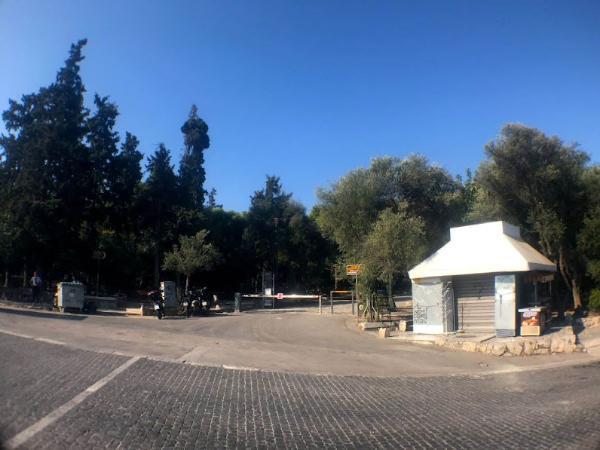
Entrance Fee
Philopappos Hill is designated a public park. No ticket or entrance fee applies to visit it.
Opening Hours
Philopappos Hill is open to the public 24/7, 365 days a year.
View
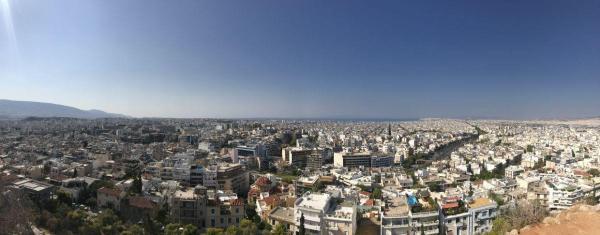
Philopappos Hil definitely offers some of the best viewpoints in Athens. This holds especially true with respect to the Acropolis. If you are looking for the best spot to take that amazing shot with the glorious, ancient rock in the background, no doubt this is the place to go. Outstanding also is the view towards the southern districts of Athens, down to Pireaus the Saronic Gulf. Every time I happen to stare at it, I cannot help conjuring up arrays of carts being carried along a long walled corridor, back and forth between the magnificent marble city and its port.
History of Philopappos Hill
The hill was known in antiquity as the Hill of the Muses. According to the geographer Pausanias, the hill was given that name in honor of the legendary poet and polymath Musaeus, whose body was believed to be buried there. Far more likely, however, is the association of the hill with the Muses and a shrine dedicated to them that must have once existed on the hill.
Due to its strategic position between Athens and its port, the hill played a significant role in the city’s defense throughout its entire long history. In mythology, it was the stronghold whence the Athenians carried out their war against the Amazons. In historical times, it served as a paramount part of Athens’ fortification.
In the Middle Ages, the hill continued to play an important defensive role. After the fourth crusade, the name Seggio became prevalent. That probably was derived from the Italian word segno meaning signal, due to the hill functioning as a communications outpost.
In 2002, shortly before the last Athens Olympics, there was a plan to fence the hill and include it in the chain of the city’s paid archeological sites. Luckily, local residents formed an active movement to oppose the plan and ultimately succeded in winning the court case in 2015, thus securing free access to the park for everyone.
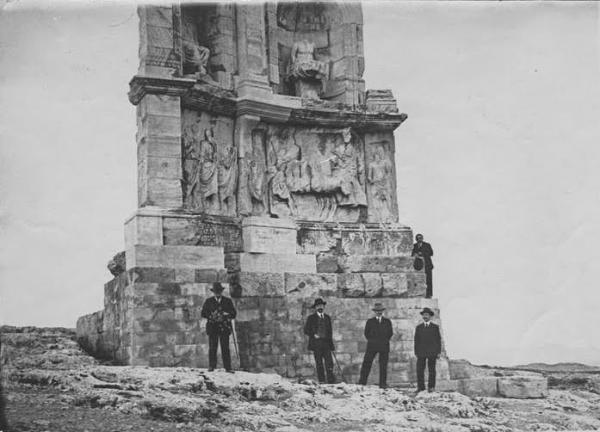
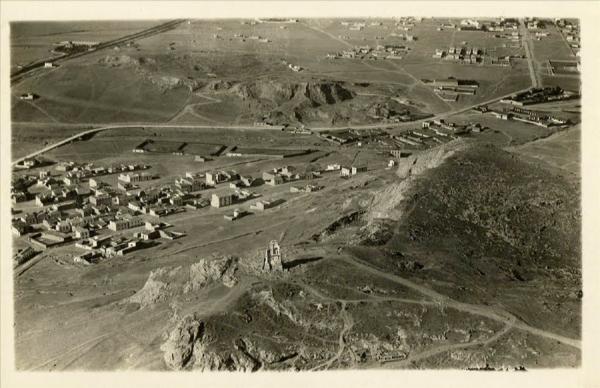
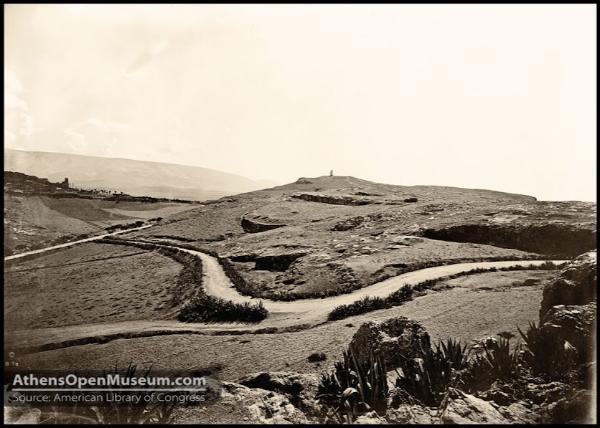
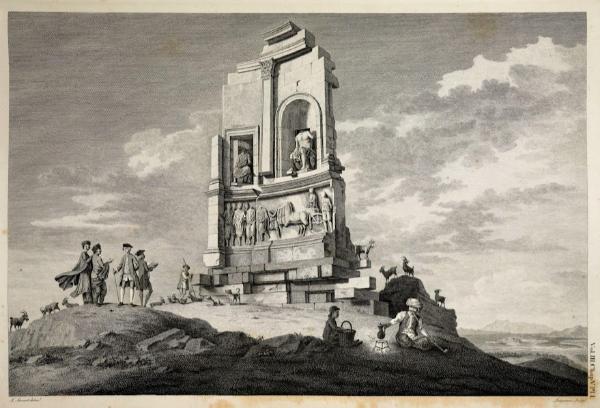
Sights within Philopappos Hill Park
Here are the most notable sights within Philopappos Hill Park. I have placed them in the order you will be visiting them if you follow the walk route I recommend below.
Saint Dimitrios Loumbardiaris Medieval Church
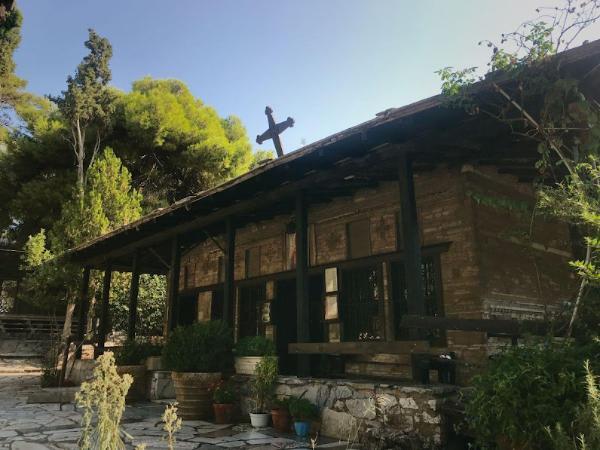
This is a single-aisle vaulted church, arguably one of the oldest churches in Athens. Its construction dates back to as early as the 9th century AD, though nobody knows for certain the exact date of its erection and, according to other sources, it may have been built much later, during the Turkish occupation. The building was last renovated in 1955 as a part of a general redevelopment program of Philopappos Hill.
Today, due to its elegance and serene environs, this church is often chosen by Athenians for weddings and baptisms.
Saint Dimitrios Loumbardiaris himself was one of those great soldier-saints of early Christianity. He lived in Thessaloniki in the 4th century AD and excelled as a military commander. He was sanctified following his execution by Roman emperor Maximian due to him having disobeyed the latter’s orders to persecute and slay the Christians of the city.
Coordinates: 37.969989, 23.720254
Kimon’s Tomb
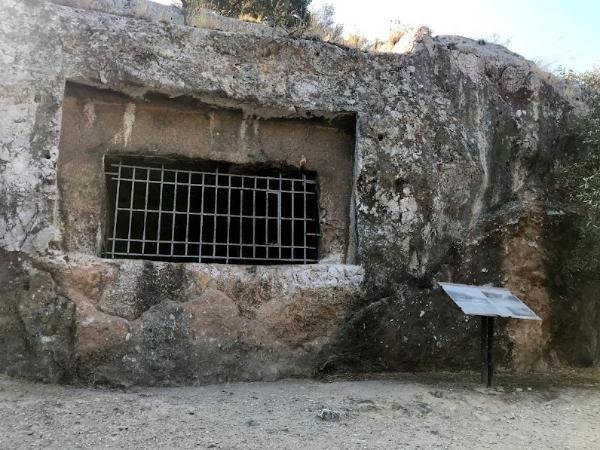
This is a twin tomb carved into a rock’s side. According to a 3rd-century-AD inscription that is preserved over its entrance, the tomb belonged to a certain bloke called Zosimianos. Tradition, however, identifies the tomb as the burial place of the Olympic victor Kimon (father of Miltiadis who won the Battle of Marathon for the Athenians) and his relative, acclaimed historian Thucydides. This belief originated from the writings of Herodotus and Plutarch.
Coordinates: 37.969706, 23.71961
Ancient Deme of Koile
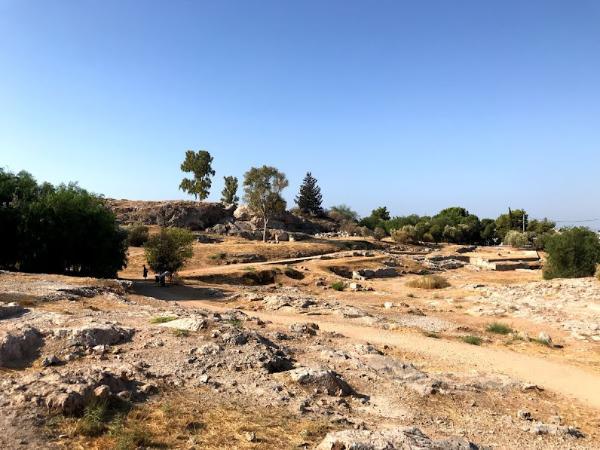
A Deme was an administrative subdivision of the ancient Greek cities. The Deme of Koile was laid out along the part of Koile Road that passed through a ravine between the hills of Philopappos and Pnyx. Koile Road was a long walled corridor that connected Athens to its port Piraeus. A 500-meter-long part of the actual ancient road has been excavated together with other eminent archeological findings. The walk down the ravine among the ruins is one of the most picturesque in the park.
Coordinates: 37.969746, 23.718309
Dora Stratou Greek Dances Theatre
This is a small modern theatre located on the southern slope of Philopappos Hill. It hosts daily performances – as well as classes and other exhibitions – exclusively of Greek traditional dances. If you are interested in dancing and folklore, you could well consider attending a show in the evening. This is their English website.
Coordinates: 37.967843, 23.717596
Seven Seats Plateau
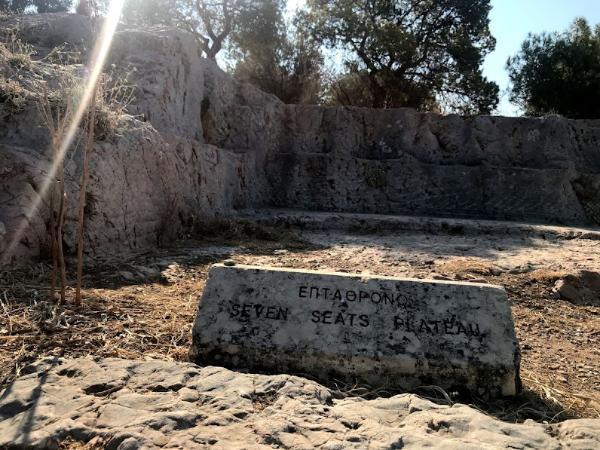
This is a sequence of seven seats carved into a piece rock. Their exact dating and use are not certain but they possibly have functioned as a sort of tribunal.
Coordinates: 37.968754, 23.718497
Andero
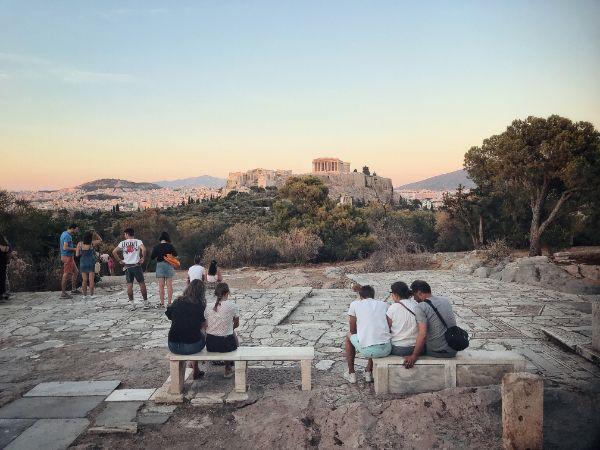
As Andero is known a nice terrace that was built during the 1950s redevelopment of the park. It is located on the spot that offers the best view of the Acropolis. A number of benches are also there for you to sit and enjoy the splendid view in the shade of the olive trees. Remnants of ancient fortification works, known as Diateichisma, are also to be seen on the spot.
Coordinates: 37.969001, 23.720275
Philopappos Monument
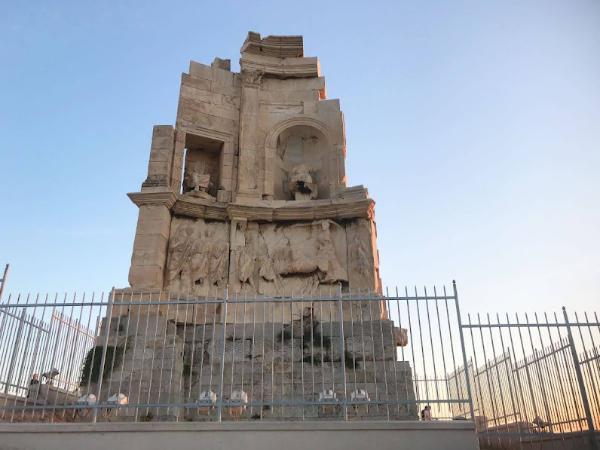
The Philopappos Monument is the most prominent feature of the park. It is located on the very summit of the hill whence it rises for an additional 10 meters. It was a mausoleum for Gaius Julius Antiochus Epiphanes Philopappos (royal folks were keen of long names).
That guy was a prince from the Kingdom of Commagene (contemporary Syria) whose family traced their ancestry to the Seleucidian Dynasty and had close ties with the Roman Emperors. Philopappos himself was an intimate friend of emperors Trajan and Hadrian and was appointed by them a senator, despite not having the required birthright to it. He lived most of his life in Athens by which he was granted citizenship.
Upon his death in 116 AD, after the initiative of his sister Julia Balbila and the funding of the Athenians and the imperial family of Rome, this gigantic tomb was erected in his memory on the top of the then Hill of the Muses. Nowadays, only a part of the tomb’s facade remains standing. If we believe the account of the Italian traveler Ciriaco de Pizzicolli, the structure was intact at least up to 1436.
Coordinates: 37.96736, 23.72145
Prison of Socrates
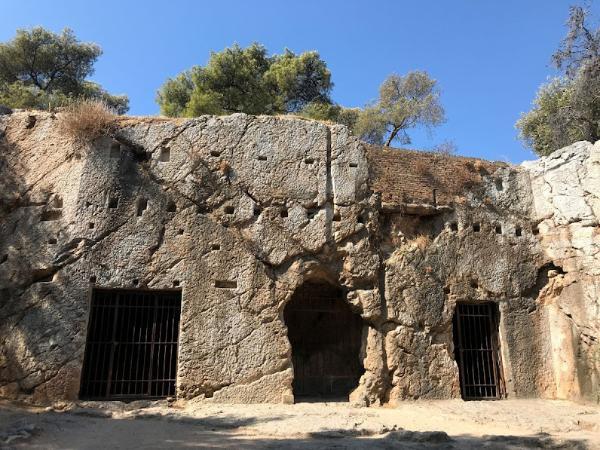
Sorry to disappoint you, but it’s very unlikely that Socrates was indeed imprisoned on this spot. There is a long-held tradition associating this cave-like cut in this rock with the place Socrates spent his concluding days, but archeological research has shown that it probably was part of a mansion of sorts, rather than a cell. No one knows for certain what this cavity was originally used for, but more recently, we know it was used as a hiding place for antiquities from the Acropolis during the Nazi occupation. As for the actual Prison of Socrates, that’s still up to aspiring, future Schliemanns to discover.
Coordinates: 37.969376, 23.720812
Recommended Walk
Here I outline a nice walking route you can follow to see all the above sights in their given order. I have also charted it on the map below.
- Enter the park from the main entrance and walk straight on the main path for 150 meters till you see the Church of Dimitris Loumbardiaris on your left hand.
- Continue straight on the main path for 50 meters. You see Kimon’s Tomb on your left side.
- Take the path leaving to the right from the main path, right opposite Kimon’s Tomb. Take the left one immediately thereafter. This is the Koile Road. Follow the path all the way down through the ravine till you reach the end of the park and Agia Sotira Church.
- Turn back the same way. After the information board, walk up the slope to the right and detour the fence around Dora Stratou Theatre.
- Walk to the northeast, get on the trail, and shortly afterward, you will see the Seven Seats Plateau on your right.
- Continue until you come to a wide paved path. Take a right turn and keep following the path as it winds to the left. It will soon lead you to the Andero. Enjoy the view and take nice pictures!
- Take the uphill trail to the south. After 200 meters, you will be standing on the top of the hill, wondering at the Monument of Philopappos.
- Follow the trail along the ridge to the southwest to get the best views of southern Athens and the sea.
- Get back to the monument and follow the narrow trail leading around it from its southern side and then downhill the hill’s northern slope.
- You will soon reach the picnic area. Follow the trail to the left. After 200 meters you will see the Prison of Socrates on your left hand.
- Continue straight and you will soon be back where you started.
- Continue exploring Athens.
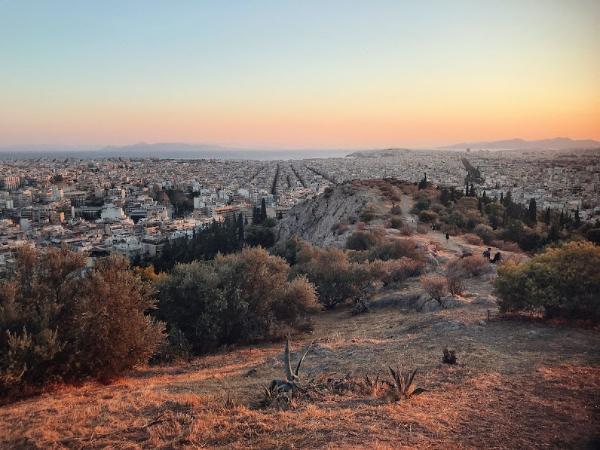
Accommodation and Activities in Athens
Stay22 is a handy tool that lets you search for and compare stays and experiences across multiple platforms on the same neat, interactive map. Hover over the listings to see the details. Click on the top-right settings icon to adjust your preferences; switch between hotels, experiences, or restaurants; and activate clever map overlays displaying information like transit lines or concentrations of sights. Click on the Show List button for the listings to appear in a list format. Booking via this map, I will be earning a small cut of the platform's profit without you being charged any extra penny. You will be thus greatly helping me to maintain and keep enriching this website. Thanks!
Philopappos Hill Map
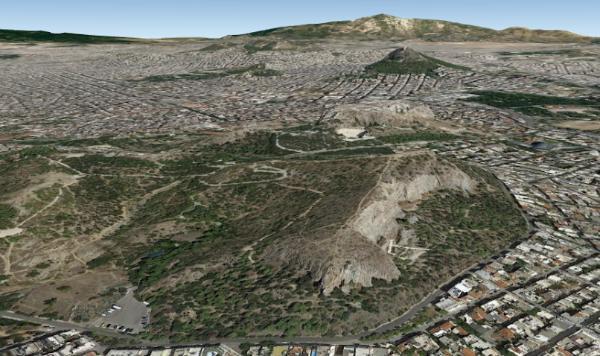
Safety
Generally speaking, it is totally safe to walk anywhere and at any time within Philopappos Park. The main trails are frequented by people even at night and the area is policed exceptionally well. However, just for any case, avoid walking alone off the trails late at night, especially if you carry something valuable with you.
Photo Gallery
View (and if you want use) all my photographs from Philopappos Hill.
More on Philopappos Hill
- Philopappos Monument -Wikipedia
- Philopappos Hill – Trip Advisor
- Philopappos Hill in Athens – Greeka
- The Philopappos Hill – The Athens Key
- Filopappou Hill – Lonely Planet
- Philopappos Hill – A View on Cities
- The Philopappos Hill – Vicity.net
- Philopappos Hill – My Guide Athens
